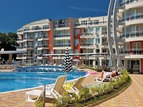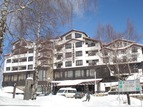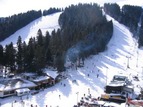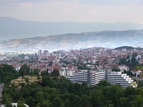“The Nativity” Church
The earliest church in Arbanassi is the Cathedral of Nativity. It is comprised of a naos (the men's section), a narthex (the women's section), a gallery running on the north and on the west, having a chapel at its eastern end dedicated to St. John the Baptist. The architectural and mural details attest that the church was built in three distinct stages. The oldest part of the church, which is indeed the naos, was, in the very beginning, a separate church. It was erected in 1597. The mural compositions of the "Last Judgement" and the "Nativity" have survived the test of time. The narthex and the chapel were built during the second stage connected with an outdoor arcade. During the third stage of building the outdoor arcade was closed up into a gallery.
The mural painting in the women's section was completed in 1638. The resources were given by two married couples - Stamati and his wife Kero, and Stati and his wife Theodora, who in fact did the painting. The painting is done in a large frame on the walls and on the ceiling. The detailed series of themes and topics - "The Life of the Virgin Mary", "The Tree of Jesse" and "Doomsday" abound in subjects and figured compositions. "Isaiah's Tree" depicts the Biblical story of the lives of Christ's predecessors. The presence of ancient philosophers and writers (Homer, Aristoteles, Plato, etc.) point at the humanistic trends of the time. The other two - "Doomsday" and "The Life of the Virgin Mary" reveal the greater interest in the cosmogonic problems – typical of the Late Middle Ages - namely the genesis and history of mankind.
The painting in the chapel of St. John the Baptist and in the gallery was done in several stages - in 1632, 1643, 1649. The inscriptions bear the names of Arbanassian donors - Stoyna, Keratsa, Niku, Hadji Georgu. The latter, on account of his excessive generosity, was depicted in two places: above the entrance door of the chapel (holding a miniature model of the church along with St. John the Baptist and Christ) and in the gallery (together with his son). The murals in the naos of the chapel reveal the life of the patron John the Baptist. The iconostasis is one of the earliest examples of superb woodcarving work in Bulgaria.
Most of the depictions in the gallery represent the menealogy for January, February and March. These calendar series comprise stories from The Old Testament - scenes revealing the martyrdom of different saints. Most impressive of all are the compositions illustrating the seven Oecumenical Councils. The big thematic cycles in the gallery are centered around the scene of "Vain Life in a Vain World" or "The Wheel of Life" which is combined with the signs of the Zodiac. The philosophy of human life is presented by a complex interaction between the Zodiac, the seasons and human destiny.
The murals in the naos were painted in 1681 with an emphasis on the Feasts, the Passions and the Miracles of Christ from the New Testament.
Every mural in the "Nativity"church is typical of the ascetic monastic art of Mount Athos presenting the entire complexity of ideas and themes on the one hand and the humanistic Renaissance approach typical of 17th century art on the other.
Other churches in Veliko Tarnovo














 Member of:
Member of:





























 Touroperator
Touroperator
